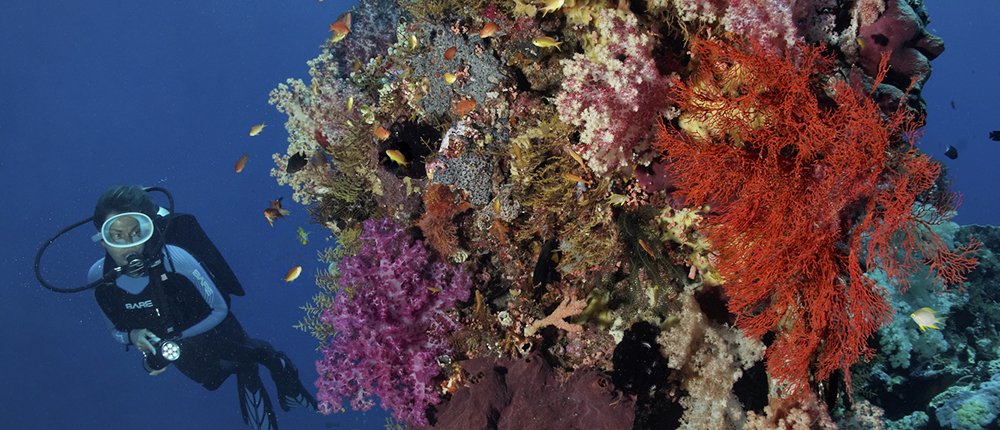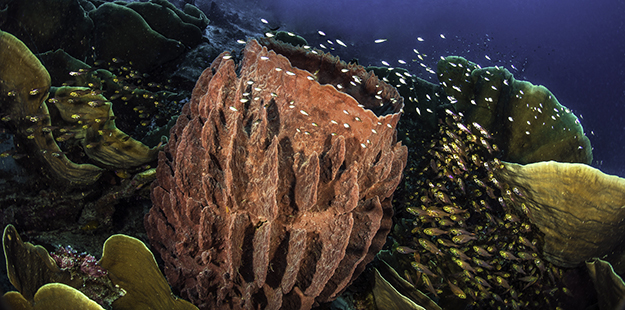Seamounts and Muck
Pelagian is your gateway to new diving adventures
Guests of Wakatobi enjoy exclusive access to some of the finest coral reefs in the world. And there’s even more awaiting the adventurous diver. From its home base at Wakatobi, the dive yacht Pelagian cruises the Wakatobi archipelago and southern Buton Island, giving access to more than 80 dive sites. In addition to reefs and walls, Pelagian takes in two other types of underwater adventures: seamounts and muck diving. For a sampling of what’s in store when you step aboard Pelagian, join us for some virtual dives that take you from open water pinnacles swarming with fish life to sheltered bays crawling with cryptic critters.
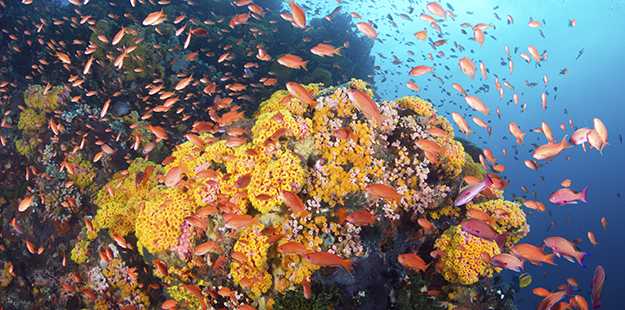
With a hard coral top, laden with anthias, the seamount at Outer Pinnacle rises to within 5 meters of the surface. It drops to depth with ridges on either side leading to deeper pinnacles. Photo by Walt Stearns
The pinnacle of adventure
After two days of diving colorful reefs and drifting steep walls, it’s time for a new type of adventure. The Pelagian moves into open water to the northeast of Hoga Island, where you join three other divers and your dive guide in one of the yacht’s twin dive tenders. Minutes later, you roll overboard into cerulean-blue water. As the bubbles from your entry clear, what looks like the top of an underwater mountain, appears. Known as the Outer Pinnacle, this seamount rises from depths of more than 70 meters to within 5 meters of the surface. The crest of this structure is covered in hard corals, and seems to shimmer. Closer inspection reveals that it is swirling schools of anthias that create this illusion.
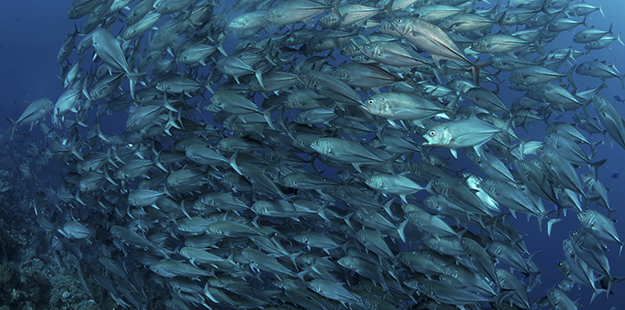
Clouds of trevally, a powerful predator in most of its habitats, are known to hunt around the seamounts. They can cause a bit of commotion among their various prey but it’s quite a show for divers. Photo by Norbert Probst
Today, the water flow is mild, and from the south. Your group begins a leisurely descent along the southern slope of the pinnacle, taking time to peer into groves of soft corals and sea fans for small treasures such as pygmy seahorses. Suddenly, the calm is interrupted by the upward flight of a school of fusiliers, which bank and turn during their upward flight to escape a pair of pursuing tuna. Soon there are more sightings: spadefish and triggers swim too and fro; a pack of giant trevally are on the hunt, and you spot a Napoleon wrasse just before sunlight is temporarily blocked by a school of chevron barracuda passing overhead. You keep an eye out for black tip and white tip sharks, which are known to frequent this site.
The descending ridge leads to a collection of huge barrel sponges growing at a depth of 30 meters. In the clear water, your eyes can follow the slope downward for what must be another 100 feet into what looks like a huge stand of black coral. But for today, this is deep enough.

Work your way up to the crest of the pinnacle for a long safety stop. Here you’ll find interesting creatures such as this leaf scorpionfish. Photo by Wakatobi Dive Resort
The group turns to the north, propelled by the gentle current as you begin a slow ascent. Along the way, there are more fish sightings. In addition to the cloud of chevron barracuda, you come across lesser gatherings of Pickhandle and Forster’s barracuda. A turtle glides by as you approach the crest of the slope, and then you are lost in a critter hunter’s playground of corals that harbor prizes such as mantis shrimp, nudibranchs, orangutan crabs and oddities such as leaf scorpionfish and false stonefish. All is located at safety-stop depths that allow you to linger and stretch your bottom time well beyond the hour mark.
Back aboard Pelagian, you enjoy a light lunch, then prepare for the next dive. This time, you explore an adjacent site known as Inner Pinnacle. Here, a pair of connected seamounts offer two distinct underwater landscapes. One side falls away on a steep wall covered in large sea fans and black coral, with schooling batfish, black and red snapper and big-eyed jacks. The other side, which is sloped and sandy, presents huge pink fans and plenty of macro life. Tonight, you will fall asleep to visions of blue water, towering walls and schooling fish.

Each Pelagian cruise is unique depending on season, weather conditions, currents, or water temperatures, which can all determine what dive areas and sites visited. The Pelagian team will also vary the type of dive sites based on the experience level of the diving group, and interest in specific types of marine life. It’s all very flexible to allow for the best possible cruise for each group. Photo by Didi Lotze
Into the muck
Two days later, Pelagian cruises into Pasar Wajo Bay on the east side of Buton Island. The sheltered coastal regions of this body of water are not noted for its reefs, but that’s OK. You’ve come here to experience muck diving, and from what you’ve been told and read, it’s not about big vistas and dramatic terrain, it’s all about looking close and moving slow.
The sun is just coming up as you make your way to the stern for an overview of the day’s first dive at Cheeky Beach. Minutes later, you load into one of the dive tenders, where your equipment sits rigged, checked and ready, as usual. Located in front of the village of Pasar Wajo, Cheeky Beach takes its name from the local children who follow along on the surface when divers are in the water, “cheekily” monitoring the underwater action with noisy curiosity. As expected, several youngsters do follow your progress from above, but the real attraction lies below. This is a shrimp breeding ground, home to a number of rare and colorful species: Harlequin, Coleman and menacing mantis shrimp, along with ghost pipefish, frogfish and crabs, which your guide finds with unerring ease. Often referred to as “a ten out of ten muck dive,” this is a site that you can dive repetitively – each time is different and critters come out depending on the time of day and lunar calendar.
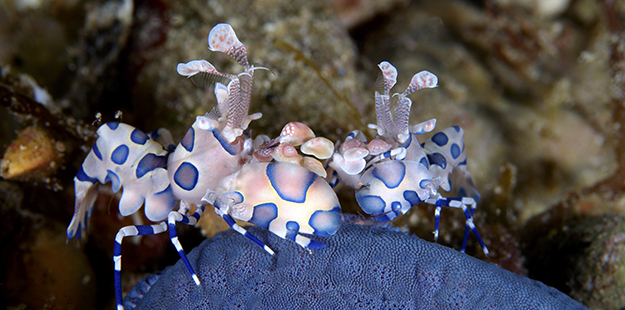
This pair of Harlequin shrimp found their favorite meals, a starfish, in the sandy bottom at Cheeky Beach. Photo by David Gray
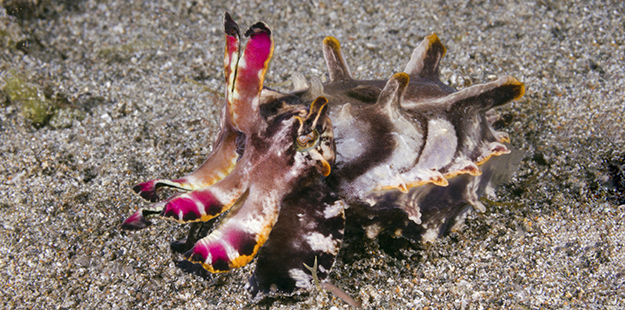
One of the rare creatures, more often found in the soft bottom areas at dusk or in the evening, is the flamboyant cuttlefish. Photo by Walt Stearns
As expected, several youngsters do follow your progress from above, but the real attraction lies below. This is a shrimp breeding ground, home to a number of rare and colorful species: Harlequin, Coleman and menacing mantis shrimp, along with ghost pipefish, frogfish and crabs, which your guide finds with unerring ease. Often referred to as “a ten out of ten muck dive,” this is a site that you can dive repetitively – each time is different and critters come out depending on the time of day and lunar calendar.


